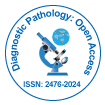Potential Diagnostic Therapies for COVID-19
Received: 26-Aug-2020 / Accepted Date: 09-Sep-2020 / Published Date: 16-Sep-2020 DOI: 10.4172/2476-2024.1000174
Editorial Note
The outbreak of Coronavirus (SARS-CoV-2) has changed the way of life. It was first identified in December 2019 in Wuhan, China. The unavailability of vaccine has put health care services on great demand and jeopardized human health. It has resulted about a progressing pandemic that led to the interference of global economy. Therapeutic interventions and Clinical diagnosis play a major role in the treatment of COVID-19 but due to the unavailability of satisfactory treatment and vaccination, it depends on the standard treatment and diagnosis at the right time.
Convalescent Plasma Therapy is one of the potential therapeutics for COVID-19. Plasma is the translucent liquid part of the blood left after the removal of red blood cells, white blood cells, platelets and other cellular components. People recovered from COVID-19 have antibodies and proteins in their blood to combat the disease. Scientists are able to isolate the antibodies from the plasma of the recovered patients and then administer them into someone who is infected with the disease to help fighting the infection until the patient's immune system produces its own kind of antibodies and stops it.
Diagnostic Pathology: Open Access has announced a Special Issue on “Therapeutic Applications in COVID-19” to provide a platform to the distinguished researchers to express their experience on successful, strategies, proactive response mechanisms and interventions and expertise on developing morphological understanding and disseminating research development on the basis of recent developments in rapidly evolving therapeutic approaches.
In the current issue of Volume 5 of the journal a Research article, Case report and a short-communication along with an Editor note were published. Garcia-Morillo et al. in their new clinical scenario, presented three elderly male patients with major accumulated tobacco consumption has originally showed non-specific general and pulmonary symptoms when corticosteroids associated with immunosuppressant therapy was applied that led to the presence of neutrophil anti-cytoplasm antibodies in the combination of pulmonary fibrosis and emphysema [1].
Omi et al. in their research on the clinical course of adenosarcoma reported that appropriate immunohistochemical staining is vital for the assessment of the prognosis of adenosarcoma from their initial pathological observation. They also stated that this is the first adenosarcoma case series comparing microscopic and immunohistochemical findings of primary and recurrent tumors [2].
Yamamoto in his Short-communication on COVID-19 emphasized that infectious diseases are by nature inherently discriminatory, i.e. they do not infect everybody equally. He also urged the investigation of the relationship between the D allele of the angiotensin-converting enzyme 1 D/I genotype and the severity of COVID-19 [4]. A glimpse on COVID-19 and the issues related were highlighted in the Editorial published by Mascellino [3].
References
- Garcia-Morillo JS, Alba DB, Suárez SR (2020) A New Clinical Scenario: the Presence of Neutrophil Anti-Cytoplasm Antibodies in the Combination of Pulmonary Fibrosis and Emphysema (CFPE). Diagn Pathol Open 5: 170.
- Omi M, Tonooka A, Chiba T, Nomura H, Kanao H, et al. (2020) Immunohistochemical Markers and the Clinical Course of Adenosarcoma: A Series of Seven Cases. Diagn Pathol Open 5: 172.
- Yamamoto N (2020) COVID-19 and the Angiotensin-Converting Enzyme 1 D/I Genotype: Protection of People at High-Risk by Predicting the Severity of the Disease. Diagn Pathol Open 5: 173.
- Mascellino MT (2020) COVID-19: All you need to now. Diagn Pathol Open 5: 169
Citation: Ferlito A ( 2020) for COV ID-19. Diagn Pathol Open 5: 174. DOI: 10.4172/2476-2024.1000174
Copyright: © 2020 Ferlito A. This is an open-access article distributed under the terms of the Creative Commons Attribution License, which permits unrestricted use, distribution, and reproduction in any medium, provided the original author and source are credited.
Share This Article
Open Access Journals
Article Tools
Article Usage
- Total views: 1756
- [From(publication date): 0-2020 - Apr 02, 2025]
- Breakdown by view type
- HTML page views: 1065
- PDF downloads: 691
